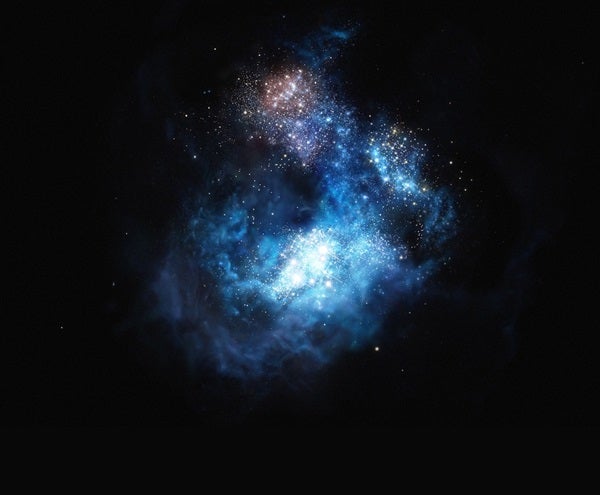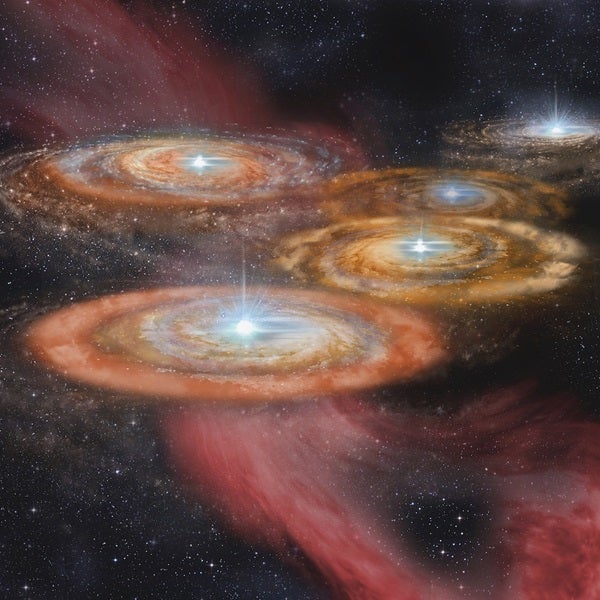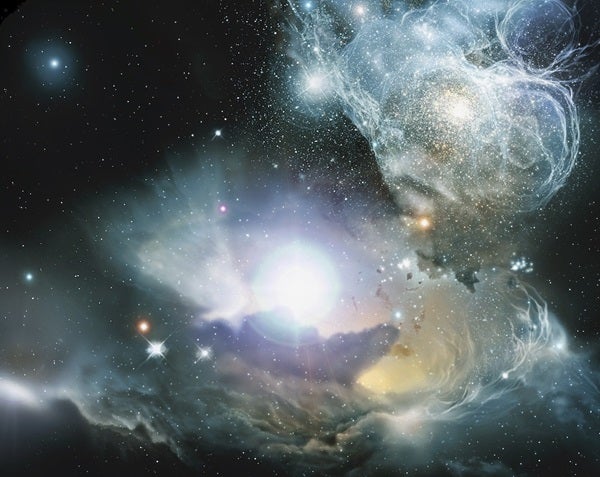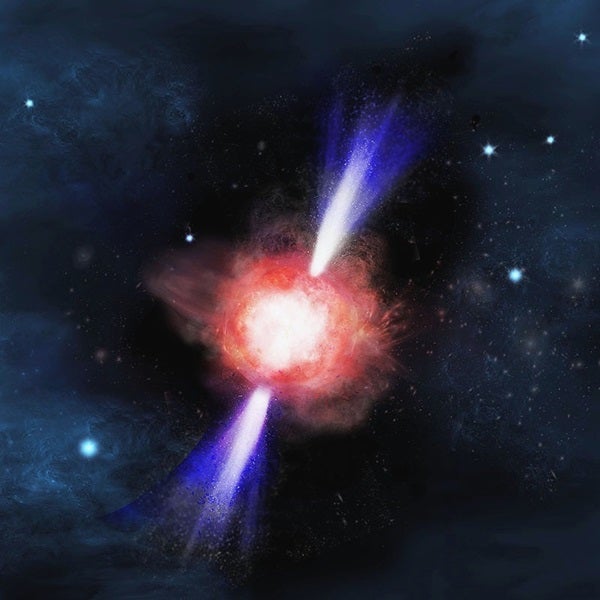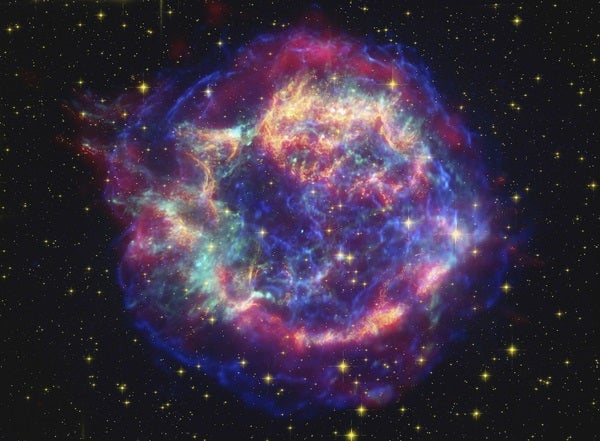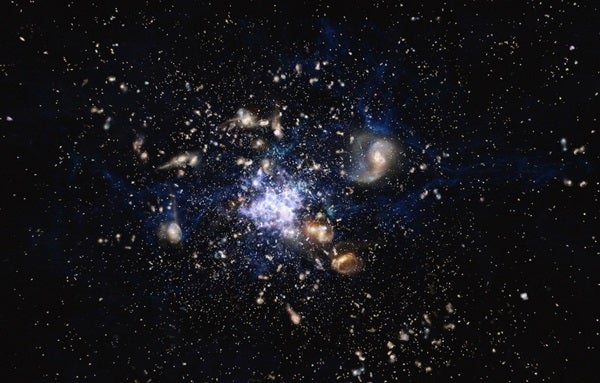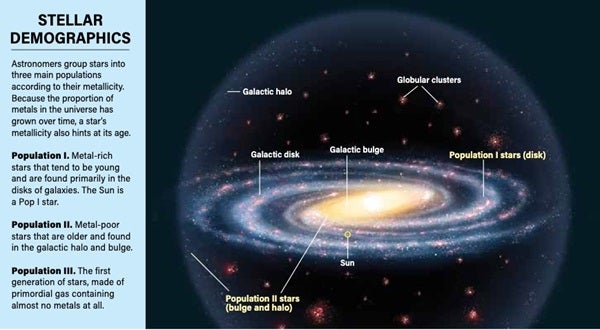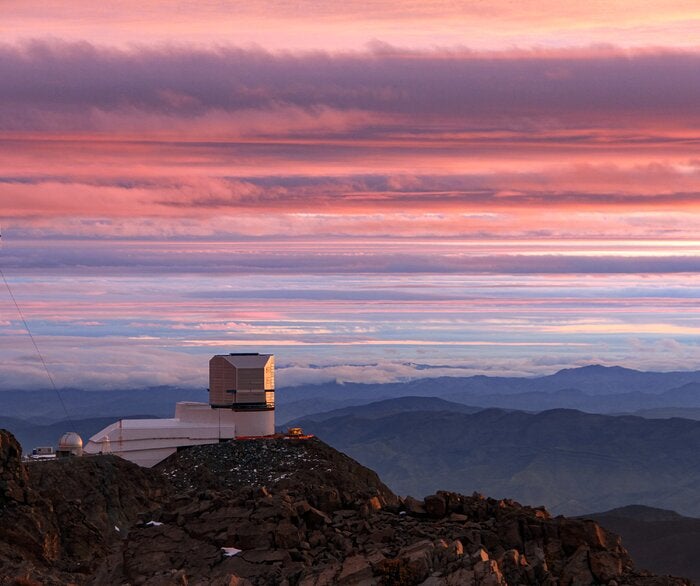This story comes from our special January 2021 issue, “The Beginning and the End of the Universe.” Click here to purchase the full issue.
For 380,000 years after the Big Bang, the cosmos was a hot, dense mixture of protons, electrons, other elementary particles, and light elements. But the expanding universe was cooling fast. And once the temperature dropped to about 4,950 degrees Fahrenheit (2,730 degrees Celsius), protons and electrons were able to form atoms.
Not all atoms, mind you. No gold was floating around, or aluminum, or even elements as light as oxygen. Hydrogen and its heavy isotope deuterium accounted for about three-quarters of everything. A couple of isotopes of helium accounted for most of the other quarter. And a tiny fraction (about one-billionth of everything) of lithium had also been produced.
Just because brand-new hydrogen and helium were swirling about doesn’t mean stars were popping into existence. In fact, the first of those luminous objects didn’t appear until the universe was about 100 million years old. So, for a span of time longer than the dinosaurs have been extinct on Earth, there were no stars or galaxies, or, for that matter, any objects emitting light.
It’s out of this darkness that astronomers are trying to piece together the origin of the first generation of stars, called Population III stars. As brightly as they shone, their light is now too faint to be detected by current observatories — and even the next generation of telescopes will struggle to spot them. But through scientific detective work, astronomers are beginning to understand how these elusive objects lived and died.
The universe lights up
A major clue comes courtesy of the cosmic microwave background (CMB), the relic radiation that formed in the hot, early universe. This radiation has been cooling ever since it was emitted as the cosmos expands — currently, the back-ground temperature is about 2.73 kelvins (–455 F, –270 C). And measurements of the CMB show that it is incredibly consistent, corresponding to density variations of only 1 part in 100,000. But those variations, literal ripples in the structure of the universe, are revealing how the first stars formed.
Computer models show that the minuscule density fluctuations in the early universe acted as starting points for immense clouds of gas. Without these variations in structure, nothing would have formed. The whole cosmos would have evolved into an ever-thinning homogeneous cloud of hydrogen, helium, and that tiny bit of lithium. Thanks to gravity, however, the fluctuations became gathering points: huge clouds where gas continued to collect. Eventually, the clouds contracted. As they did, they heated up to more than 1,300 F (700 C).
That temperature would be far too high for a star-forming region today to form stars. Indeed, if a cloud is hotter than about 10 kelvins (–442 F, –263 C), the speed of the atoms inside it will be too fast for them to stick together and eventually form stars.
But the clouds in the early universe were larger and much more densely packed than modern-day nebulae. Within them, some hydrogen atoms paired up to become hydrogen molecules. And because molecules are better emitters of infrared radiation (heat), the temperature dropped and clumps inside the clouds could contract further.
Each of the regions was probably several hundred times as massive as the Sun. That much mass, and its corresponding gravity, could overcome the outward pressure from radiation. The clumps didn’t split as they contracted, so only a single star formed from each one. The result was that the first stars were potentially colossal — estimates range from several tens of solar masses up to 1,000 solar masses — and luminous, perhaps millions of times as bright as the Sun.
Because the universe was smaller and denser, vast numbers of these stars formed near each of its density variations. Eventually, the gravitational pull from these stars would attract other stars, and the numbers grew from there. Astronomers think this took a few hundred million years, but, at the end of that time, the first galaxies had formed.
A first star’s life
You may be wondering how anyone could figure out how stars formed during a time when the universe was unobservable. Fortunately, the cosmos wasn’t as complex then as it is now, making it simpler for cosmologists to model.
For example, they don’t have to account for shock waves from supernovae compressing the material within distant nebulae. All available material was one of the three lightest elements. There wasn’t even any dust yet to affect how the clouds cool.
Astronomers theorize that, in addition to being massive, the first stars also were extremely hot. Their surface temperatures may have been 15 to 20 times that of the Sun, and most of the radiation they emitted was in the ultraviolet region of the spectrum.
Theory predicts that when a star with a mass between 140 and 260 times that of the Sun reaches the end of its life, it produces a pair-instability supernova. In the core of such an object, electron-positron pairs upset the balance between outward radiation pressure and the inward pull of gravity.
As gravity starts to win this tug-of-war, the core collapses. That, in turn, raises its temperature and causes a huge increase in fusion — so much, in fact, that the star blows up completely, without leaving behind any stellar remnant (such as a black hole). In this way, all the elements the star had synthesized, up to and including iron, are blasted into space. This seeds the surrounding gas with material, creating the mixture that would form future generations of stars. So, in one sense, the deaths of these stars are as important for the development of the universe as their births.
Is dark matter involved?
According to theoreticians, our part of the universe — what we can see and touch — accounts for only 5 percent of the total. The rest is either dark energy (about 69 percent) or dark matter (26 percent). Dark energy does its own thing, which seems to be accelerating the expansion of the universe.
Dark matter also doesn’t interact with normal matter — except through gravity. So, although it’s impossible to see directly, astronomers can detect it indirectly.
Some scientists now think that dark matter’s gravitational tug was crucial in pulling normal material together into clumps and patches (the density fluctuations in the CMB) in the years following the Big Bang. These objects, called dark matter minihalos, would have to have been massive — on the order of a million Suns or more.
Normal matter would have needed the gravity of that much mass to overcome the speed of the atoms as the star-forming cloud contracted and heated up. If the minihalo were too small, the atoms wouldn’t merge to eventually form stars.
The next best thing
No telescope — on Earth or in space — is currently powerful enough to detect the light of a Population III star. But some scientists think that evidence of what the first stars were like lies a lot closer. They are looking for the second generation of stars, concentrating their search in the Milky Way’s halo, a spherical region of old stars and globular clusters — Population II stars — centered on our galaxy’s core.
Unlike the Milky Way’s disk, which has abundant gas and dust and is filled with young stars — called Population I stars — no new stars are forming in the halo. Compared to the Sun, Pop II stars in the halo contain a smaller fraction of metals — a term that in astronomy refers to any element heavier than helium. And some hyper-metal-poor (HMP) stars might provide clues to unravel how the first stars lived and died because their atmospheres haven’t changed much since they formed.
The first two HMP stars discovered were HE 0107-5240 in the constellation Phoenix in 2002 and HE 1327-2326 in Hydra in 2005. Each has only 0.001 percent or less of the Sun’s total iron abundance.
In 2019, Rana Ezzeddine, then at MIT (now at the University of Florida), and her team found observational evidence that HE 1327-2326 probably formed in a region of the early universe that had been enhanced by the supernova explosion of a first star with a mass 25 times that of the Sun.
The lowest known iron abundance belongs to the star SMSS J031300.36-670839.3 in the small constellation Hydrus. Discovered in 2014, this star lies 6,000 light-years away. At 13.6 billion years old, it is the oldest star whose age has been determined accurately, and probably one of the earliest second-generation stars to have formed.
To the hunt
For now, astronomers’ best hope of directly detecting a Pop III star could lie with NASA’s James Webb Space Telescope (JWST), which is scheduled to launch in October 2021. Although its 6.5-meter mirror will be unable to reveal one of the first stars on its own, it could get lucky. Perhaps it could catch an ultra-faint flash that signals one of the first stars becoming a supernova.
Or, if a large galaxy cluster comes in between a Pop III star and JWST, it might act as a gravitational lens, bending and magnifying the light of the star. A 2018 study led by researchers at Arizona State University and the University of Melbourne found JWST might be able to find a few of these first stars if it monitors 30 galaxy clusters twice a year over its estimated lifespan of five to 10 years.
Of course, researchers can dream of building a giant telescope so powerful it could capture the light of Pop III stars unaided.
How fanciful is this prospect? Anna Schauer and her colleagues at the University of Texas calculate that a telescope with a mirror 100 meters wide would suffice — if it were placed on the Moon, that is. Their proposed observatory, dubbed the Ultimately Large Telescope and posted in an online preprint last July, would lie in the eternal shadow of a lunar crater at the Moon’s South Pole, isolated from heat that could interfere with its infrared observations.
Could that happen soon? Yes — at least astronomically speaking.

